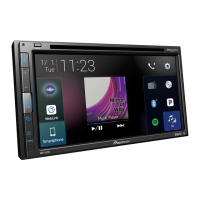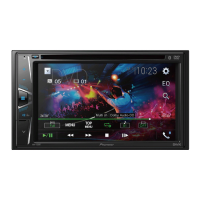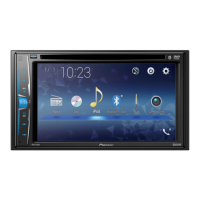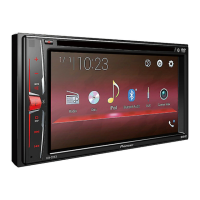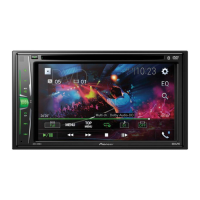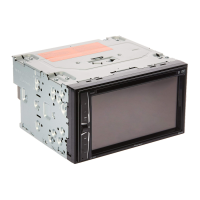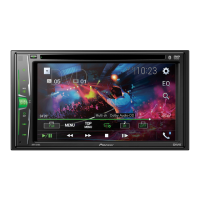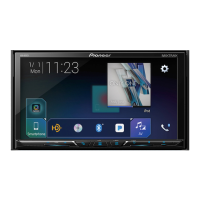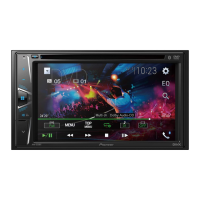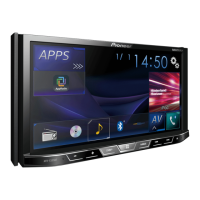Do you have a question about the Pioneer AVH-500EX and is the answer not in the manual?
Regulatory compliance and user information regarding device operation and safety guidelines.
Critical safety warnings and precautions for installation, operation, and general use of the product.
Explanation of the parking brake interlock system and its importance for safe driving.
Guidelines for connecting an external display for rear seat viewing, ensuring driver safety.
Advice on preventing unnecessary battery drain when using the unit.
How to use the product with an optional rear view camera for parking assistance.
Precautions for safely connecting and using USB storage devices to prevent data loss or damage.
Identification and description of the main unit's components and controls.
Description of the remote control's buttons and their functions.
Guidelines for using the LCD panel, including notes on care and angle adjustment.
Steps to reset the unit's microprocessor to factory default settings.
Instructions for preparing the remote control, including battery replacement.
A step-by-step guide on how to start the system and complete initial setup.
How to operate the unit's functions using the touch screen interface.
Procedures for establishing a wireless connection between your phone and the unit.
How to configure various Bluetooth options like visibility, auto-connect, and PIN.
Managing multiple connected Bluetooth devices and switching between them.
Using the unit for making and receiving phone calls wirelessly via Bluetooth.
Streaming music from a Bluetooth-enabled device to the unit's audio system.
Operating compatible smartphone applications directly through the unit's interface.
Steps to connect your smartphone and launch the AppRadio Mode + application.
How to input text using the on-screen keyboard within AppRadio Mode + applications.
Combining audio from AV sources and smartphone apps for a mixed sound experience.
A list of all available audio and video sources that can be connected and played.
How to access and navigate the primary screen for controlling AV sources.
The process for choosing and switching between different connected audio/video inputs.
Customizing the arrangement of source icons or keys on the screen for easier access.
Modifying the size of the area used for displaying favorite source icons.
Connecting iPod and iPhone devices that use a Lightning connector.
Connecting older iPhone models that utilize a 30-pin connector.
Steps to connect Android smartphones for audio and data transfer.
An overview of HD Radio features, including audio quality and data services.
Initial steps required to set up and begin using the HD Radio tuner.
How to tune, seek, scan, and manage HD Radio stations.
Automatically saving the strongest radio stations to preset memory keys.
Options for customizing radio tuning, seeking methods, and blending analog/digital signals.
Detailed instructions for safely inserting and removing various types of discs.
How to play back audio and video content from CDs, DVDs, and Video-CDs.
Procedures for inserting and ejecting compressed audio, video, or image files.
Guidelines for connecting, plugging, and unplugging USB storage devices.
How to play back compressed audio and video files from USB storage.
Steps to connect your iPod to the unit for audio playback and control.
Navigating iPod menus, selecting music, and controlling playback.
How to set up and stream music from the Pandora internet radio service.
Controlling Pandora playback, managing stations, and using playback features.
Instructions for connecting and streaming music from the Spotify music service.
How to control Spotify playback, save songs, and switch between modes.
Guide to activating your SiriusXM subscription and obtaining your Radio ID.
How to tune into SiriusXM channels and navigate live broadcasts.
Controls for channel selection, presets, bands, and other SiriusXM functions.
Using TuneScan to preview songs from preset SiriusXM music channels.
Setting up alerts for significant plays during sports broadcasts.
How to restrict access to channels with mature content using a passcode.
Customizing various SiriusXM features like Tune Start, Featured Favorites, and resets.
Steps to connect and configure the AUX input for audio and video sources.
How to select and manage content from the AUX input.
How to activate and configure AV sources or camera inputs for display.
Using MIXTRAX EZ to create non-stop music mixes with DJ effects from USB audio files.
Customizing MIXTRAX playback modes, effects, and flash patterns.
Accessing vehicle information and OEM system data via the iDatalink adapter.
Steps to flash firmware and activate the Maestro RR module for vehicle integration.
Connecting the iDatalink adapter and initiating its functions.
Operating vehicle-specific features like gauges, climate control, and parking assist.
How to navigate to the main settings menu.
General system configuration, AV source activation, and beep tone settings.
Customizing the unit's visual appearance, including background and illumination colors.
Adjusting sound parameters like equalizer, fader, balance, and speaker levels.
Configuring options for DVD playback, including language, aspect ratio, and parental controls.
Registering frequently accessed menu items for quick access via shortcuts.
How to use the created shortcuts to jump to specific menu screens.
Deleting or removing previously registered favorite menu shortcuts.
Adjusting the unit's internal clock and date display.
Setting the screen aspect ratio for AV sources and image files.
Resetting all user-configurable settings and recorded content back to factory defaults.
Solutions for frequent operational issues and errors encountered with the product.
Steps to resolve problems related to AV input, video output, and screen display.
A guide to understanding and resolving error messages shown on the unit's display.
Important precautions and methods for handling discs to ensure proper playback and prevent damage.
Details on the types of discs supported, including compatibility and limitations.
Comprehensive specifications for compatible media formats for discs and USB storage devices.
| Screen Size | 6.2 inches |
|---|---|
| Resolution | 800 x 480 |
| Bluetooth | Yes |
| USB Ports | 1 |
| AUX Input | Yes |
| SiriusXM Ready | Yes |
| DVD Player | Yes |
| Backup Camera Input | Yes |
| Preamp Outputs | 3 (front, rear, subwoofer) |
| Peak Power Output | 50 watts x 4 channels |
| Equalizer | 13-band graphic equalizer |
| Apple CarPlay | Yes |
| Android Auto | Yes |
| HD Radio | No |
| CD Player | Yes |
| AM/FM Tuner | Yes |
| Audio Formats Supported | MP3, WMA, AAC |
| Video Formats Supported | MPEG-1, MPEG-2, MPEG-4, AVI |
| Video Output | Yes |
| Audio Output | 3 RCA (Front, Rear, Subwoofer) |

